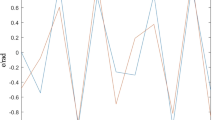Abstract
With the in-depth development of high-tech industries, especially in the fields of production, manufacturing, aviation, and medical care, most of the work needs to be accomplished with the help of machines. As a high-tech product, a robotic arm plays an irreplaceable role in high-risk and high-precision engineering, such as arc welding, spraying, and assembly. At the same time, with the increasing requirements of scientific and technological production processes, robotic arm tasks are becoming increasingly complicated. Robotic arm trajectory tracking control in industry also has increasingly higher standards. Furthermore, external interference sources invariably affect the robotic arm control system when it is in operation. Therefore, existing manipulator control systems can no longer meet the requirements of industrial production. This paper aims to realize the tracking control of the trajectory of a robotic arm through a neural network algorithm. This research offers an adaptive neural network control method to solve the manipulator trajectory tracking control problem. To increase the control effect and overall performance of the manipulator, a neural network is employed to address the uncertainty in the control system as well as the interference of external elements. Experiments reveal that a neural network-based manipulator trajectory control and tracking system can effectively regulate the manipulator's operation and improve its overall performance.









Similar content being viewed by others
Data availability
Data sharing not applicable to this article as no datasets were generated or analyzed during the current study.
References
Kojima H (2017) Trajectory planning of CP control flexible robot arm using genetic algorithm. Trans Jpn Soc Mech Eng 68(670):1784–1790
Jiang W, Wu G, Wang W, Zhang J, Fan F, Ye X (2018) Robust motion control of live-line maintenance robot mechanical arm for high-voltage transmission line based on H theory. Trans Inst Meas Control 40(3):951–967
Panwar V (2017) Wavelet neural network-based H∞ trajectory tracking for robot manipulators using fast terminal sliding mode control. Robotica 35(7):1–16
Zhang J, Meng WJ, Tao S, Guo ZF, Gao XH (2020) Design and simulation of space pose controller for mine-used bolter manipulator based on fractional order algorithm. Appl Mech Mater 900(34):20–26
Nu Z, Niu W, Junrong Z (2017) Research on optimized control of six - DOF manipulator with uncalibrated visual servo. AIP Conf Proc 1834(1):1–7
Min W, Yang A (2017) Dynamic learning from adaptive neural control of robot manipulators with prescribed performance. IEEE Trans Syst Man Cybernet Syst 47(8):2244–2255
Lavín-Delgado JE, Solís-Pérez JE, Gómez-Aguilar JF, Escobar-Jiménez RF (2020) Trajectory tracking control based on non-singular fractional derivatives for the PUMA 560 robot arm. Multibody SysDyn 50(3):259–303
Yoshimi T, Takezawa K, Hirayama M (2018) An improvement of trajectory tracking accuracy of automatic sewing robot system by variable gain learning control. IFAC-PapersOnLine 51(22):1–6
Reboucas Filho PP, da Silva SPP, Praxedes VN, Hemanth J, de Albuquerque VHC (2019) Control of singularity trajectory tracking for robotic manipulator by genetic algorithms. J Comput Sci 30(67):55–64
Reynoso F, Suarez P, Sanchez O, Yaez MBC, Flores EAP (2020) A custom EOG-based HMI using neural network modeling to real-time for the trajectory tracking of a manipulator robot. Front Neurorobot 14(56):578–584
Fareh R, Saad MR, Saad M (2019) Trajectory tracking and stability analysis for mobile manipulators based on decentralized control. Robotica 2019(45):1–18
Jiang W, Ye F, Liu W, Liu X, Liang G, Xu Y et al (2020) Research on prediction methods of prevalence perception under information exposure. Comput Mater Continuum 2020(12):13–13
Xia J, Jiang ZN, Zhang T (2021) Feasible arm configurations and its application for human-like motion control of S-R-S-redundant manipulators with multiple constraints. Robotica 39(9):1–17
Xu F, Wang H, Wang J (2019) Underwater dynamic visual servoing for a soft robot arm with online distortion correction. IEEE/ASME Trans Mechatron 345(34):979–989
Shi S, Wu H, Song Y et al (2017) Static stiffness modelling of EAST articulated maintenance arm using matrix structural analysis method. Fusion Eng Des 124(11):507–511
Hwang CL, Yu WS, Abebe HB (2020) Tracking and cooperative designs of robot manipulators using adaptive fixed-time fault-tolerant constraint control. IEEE Access 79(99):1–1
Zhen SC, Zhao Z, Liu X, Chen F, Chen YH (2020) A novel practical robust control inheriting PID for SCARA robot. IEEE Access 8(99):1–1
Yang C, Wang X, Li Z, Li Y, Suet CY (2017) Teleoperation control based on combination of wave variable and neural networks. IEEE Trans Syst Man Cybernet Syst 47(8):2125–2136
Huang YC, Su YW, Chuo PC (2017) Iterative learning control bandwidth tuning using the particle swarm optimization technique for high precision motion. Microsystem Technol 23(2):361–370
Lei YA, Wx A, Zh A et al (2020) Multi-objective configuration optimization for coordinated capture of dual-arm space robot. Acta Astronaut 167(78):189–200
Funding
This work was supported by Key Scientific and Technological Project of Henan Province (222102210121).
Author information
Authors and Affiliations
Corresponding author
Ethics declarations
Conflict of interests
There is no potential competing interests in our paper. And all authors have seen the manuscript and approved to submit to your journal. We confirm that the content of the manuscript has not been published or submitted for publication elsewhere.
Additional information
Publisher's Note
Springer Nature remains neutral with regard to jurisdictional claims in published maps and institutional affiliations.
Rights and permissions
Springer Nature or its licensor holds exclusive rights to this article under a publishing agreement with the author(s) or other rightsholder(s); author self-archiving of the accepted manuscript version of this article is solely governed by the terms of such publishing agreement and applicable law.
About this article
Cite this article
Xu, K., Wang, Z. The design of a neural network-based adaptive control method for robotic arm trajectory tracking. Neural Comput & Applic 35, 8785–8795 (2023). https://doi.org/10.1007/s00521-022-07646-y
Received:
Accepted:
Published:
Issue Date:
DOI: https://doi.org/10.1007/s00521-022-07646-y




